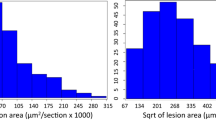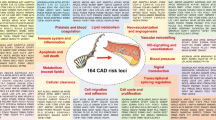Abstract
Recent studies in mice have revealed genetic factors contributing to atherosclerosis that are independent of known risk factors. These factors appear to act locally, at the level of the vessel wall. In this review, we discuss these studies and summarize some of the cellular and molecular interactions that may be involved. We also outline the approaches for the identification of such factors in humans.
Similar content being viewed by others
References
Motulsky AG, Brunzell JD: The genetics of coronary atherosclerosis. In The Genetic Basis of Common Disease. Edited by King RA, Rotter JI, Motulsky AG. New York: Oxford University Press; 1992:150–169.
Shi W, Wang NJ, Shih DM, et al.: Determinants of atherosclerosis susceptibilty in the C3H and C57BL/6 mouse model: evidence for involvement of endothelial cells but not blood cells or cholesterol metabolism. Circ Res 2000, in press.
Shi W, Haberland ME, Jien ML, et al.: Endothelial responses to oxidized lipoproteins determine genetic susceptibilty to atherosclerosis in mice. Circulation 2000, in press.
Qiao J-H, Xie P-Z, Fishbein MC, et al.: Pathology of atheromatous lesions in inbred and genetically engineered mice: genetic determination of arterial calcification. Arterioscl Thromb 1994, 14:1480–1497.
Schinke T, McKee MD, Kiviranta R, Karsenty G: Molecular determinants of arterial calcification. Ann Med 1998, 30:538–541.
Luo G, Ducy P, McKee MD, et al.: Spontaneous calcification of arteries and cartilage in mice lacking matrix GLA protein. Nature 1997, 386:78–81.
Bucay N, Sarosi I, Dunstan CR, et al.: Osteoprotegerin-deficient mice develop early onset osteoporosis and arterial calcification. Genes Develop 1998, 12:1260–1268.
Ivandic BT, Qiao J-H, Machleder D, et al.: A locus on chromosome 7 determines myocardial cell necrosis and calcification (dystrophic cardiac calcinosis) in mice. Proc Nat Acad Sci USA 1996, 93:5483–5488.
Berliner JA, Haberland ME: The role of oxidized low-density lipoproteins in atherogenesis. Curr Opin Lipid 1993, 4:373–381.
Cyrus T, Witztum JL, Rader DJ, et al.: Disruption of the 12/15-lipoxygenase gene diminishes atherosclerosis in apoE-deficient mice. J Clin Invest 1999, 103:1597–1604.
Shih DM, Gu L, Hama S, et al.: Genetic-dietary regulation of serum paraoxonase expression and its role in atherogenesis in a mouse model. J Clin Invest 1996, 97:1630–1639.
Ivandic B, Castellani LW, Wang XP, et al.: Role of group II secretory phospholipase A2 in atherosclerosis: increased atherogenesis and altered lipoproteins in transgenic mice expressing group IIa phospholipase A2. Arterioscl Thromb Vasc Biol 1999, 19:1284–1290.
Dong ZM, Chapman SM, Brown AA, et al.: The combined role of P- and E-selectins in atherosclerosis. J Clin Invest 1998, 102:145–152.
Gu L, Okada Y, Clinton SK, et al.: Absence of monocyte chemoattractant protein-1 reduces atherosclerosis in low density lipoprotein receptor-deficient mice. Molecular Cell 1998, 2:275–281.
Boring L, Gosling J, Cleary M, Charo IF: Decreased lesion formation in CCR2-/- mice reveals a role for chemokines in the initiation of atherosclerosis. Nature 1998, 394:894–897.
Rajavashisth T, Qiao J-H, Tripathi S, et al.: Heterozygous osteopetrotic (op) mutation reduces atherosclerosis in LDL receptor-deficient mice. J Clin Invest 1998, 101:2702–2710.
Fazio S, Babaev VR, Murray AB, et al.: Increased atherosclerosis in mice reconstituted with apolipoprotein E null macrophages. Proc Nat Acad Sci USA 1997, 94:4647–4652.
Febbraio M, Podrez EA, Smith JD, et al.: Targeted disruption of the class B scavenger receptor CD36 protects against atherosclerosis lesion development in mice. J Clin Invest 2000, 105:1049–1056.
Escary JL, Choy HA, Reue K, et al.: Paradoxical effect on atherosclerosis of hormone-sensitive lipase overexpression in macrophages. J Lipid Res 1999, 40:397–404.
Suzuki H, Kurihara Y, Takeya M, et al.: A role for macrophage scavenger receptors in atherosclerosis and susceptibility to infection. Nature 1997, 386:292–296.
Schreyer SA, Peschon JJ, LeBoeuf RC: Accelerated atherosclerosis in mice lacking tumor necrosis factor receptor p55. J Biol Chem 1998, 271:26174–26178.
Lutgens E, Gorelik L, Daemen MJ, et al.: Requirement for CD154 in the progression of atherosclerosis. Nat Med 1999, 5:1313–1316.
Gupta S, Pablo AM, Jiang X, et al.: IFN-g potentiates atherosclerosis in ApoE knockout mice. J Clin Invest 1999, 99:252–2761.
Pinderski-Oslund LJ, Hedrick CC, Olvera T, et al.: Interleukin-10 blocks atherosclerotic events in vitro and in vivo. Arterioscler Thromb Vasc Biol 1999, 19:2847–2853.
Akar N, Aras O, Omurlu K, Cin S: Deletion polymorphism at the angiotensin-converting enzyme gene in Turkish patients with coronary artery disease. Scand J Clin and Lab Invest 1998, 58:491–495.
Hubacek JA, Pit’ha J, Skodova Z, et al.: C260ÆT polymorphism in the promoter of the CD14 monocyte receptor gene as a risk factor for myocardial infarction. Circulation 1999, 99:3218–3220.
Hingorani AD, Liang CF, Fatibene J, et al.: A common variant of the endothelial nitric oxide synthase (Glu298ÆAsp) is major risk factor for coronary artery disease in the UK. Circulation 1999, 100:1515–1520.
Kohler HP, Futers TS, Grant PJ: Prevalence of three common polymorphisms in the A-subunit gene of factor XIII in patients with coronary artery disease. Thromb Haemost 1999, 81:511–515.
Carter AM, Ossei-Gerning N, Wilson IJ, Grant PJ: Association of the platelet P1(A) polymorphism of glycoprotein IIb/IIIa and the fibronogen Bbeta 448 polymorphism with myocardial infarction and extent of coronary artery disease. Circulation 1997, 96:1424–1431.
Tuomainen T-P, Kontula K, Nyysönen K, et al.: Increased risk of acute myocardial infarction in carriers of the hemachromatosis gene Cys282 Tyr mutation. Circulation 1999, 100:1274–1279.
Roest M, van der Schouw YT, de Valk B, et al.: Heterozygosity for a hereditary hemachromatosis gene is associated with cardiovascular death in women. Circulation 1999, 100:1268–1273.
Pfohl M, Koch M, Enderle MD, et al.: Paraoxonase 192 Gln/Arg gene polymorphism, coronary artery disease, and myocardial infarction in type 2 diabetes. Diabetes 1999, 48:623–627.
Aubo C, Senti M, Marrugat J, et al.: Risk of myocardial infarction associated with Gln/Arg 192 polymorphism in the human paraoxonase gene and diabetes mellitus: the REGICOR Investigators. Eur Heart J 2000, 21:33–38.
Ye S, Eriksson P, Hamsten A, et al.: Progression of coronary atherosclerosis is associated with a common genetic variant of the human stromrlysin-1 promoter which results in reduced gene expression. J Biol Chem 1996, 271:13055–13060.
Nordestguard BG, Nielson LB: Atherosclerosis and arterial influx of lipoproteins. Curr Opin Lipid 1994, 5:252–257.
Borén J, Oli K, Lee I, et al.: Identification of the principal proteoglycan-binding site in LDL: a single-point mutation in apo-B100 severely affects proteoglycan interaction without affecting LDL receptor binding. J Clin Invest 1998, 101:2658–2664.
Nageh MF, Sandberg ET, Marotti KR, et al.: Deficiency of inflammatory cell adhesion molecules protects against atherosclerosis in mice. Arterioscler Thromb Vasc Biol 1997, 17:1517–1520.
Accad M, Smith SJ, Newland DL, et al.: Massive xanthomatosis and altered composition of atherosclerotic lesions in hyperlipidemic mice lacking acyl CoA:cholesterol acyltransferase 1. J Clin Invest 2000, 105:711–719.
Grainger DJ, Metcalfe JC: A pivotal role for TGFB in atherogenesis? Biol Rev 1995, 70:571–596.
Galis ZS, Sukhova GK, Lark MW, Libby P: Increased expression of matrix metalloproteinases and matrix degrading activity in vulnerable regions of human atherosclerotic plaques. J Clin Invest 1994, 94:2493–2503.
Nishimura RA, Edwards WD, Warnes CA, et al.: Intravascular ultrasound imaging: in vitro validation and pathologic correlation. J Am Coll Cardiol 1990, 16:145–154.
Stefanadis C, Diamantopoulos L, Vlachopoulos C, et al.: Thermal heterogeneity within human atherosclerotic coronary arteries detected in vivo: a new method of detection by application of a special thermography catheter. Circulation 1999, 99:1965–1971.
Ludmer PL, Selwyn AP, Shook TL: Paradoxical vasoconstriction induced by acetylcholine in atherosclerotic coronary arteries. N Engl J Med 1986, 315:1046–1051.
O’Leary DH, Polak JF, Kronmal RA, et al.: Carotid-artery intima and media thickness as a risk factor for myocardial infarction and stroke in older patients. N Engl J Med 1999, 340:14–22.
Adams MR, Nakagomi A, Keech A, et al.: Carotid intima-media thickness is only weakly correlated with the extent and severity of coronary artery disease. Circulation 1995, 92:2127–2134.
Mautner GC, Mautner SL, Froehlich J, et al.: Coronary artery calcification: assessment with electron beam CT and histomorphormetric correlation. Radiology 1994, 192:619–623.
Achenbach S, Moshage W, Ropers D, et al.: Value of electron-beam computed tomography for the noninvasive detection of high-grade coronary-artery stenoses and occlusions. N Eng J Med 1998, 339:1964–1971.
Skinner MP, Yuan C, Mitsumori L, et al.: Serial magnetic resonance imaging of experimental atherosclerosis detects lesion fine structure, progression and complications in vivo. Nat Med 1995, 1:69–73.
Vallabhajosula S, Fuster V: Atherosclerosis: imaging techniques and the evolving role of nuclear medicine. J Nucl Med 1997, 38:1788–1796.
Schroeder S, Enderle MD, Ossen R, et al.: Noninvasive determination of endothelium-mediated vasodilatation as a screening test for coronary artery disease: pilot study to assess the predictive value in comparison with angina pectoris, exercise electrocardiography, and myocardial perfusion imaging. Am Heart J 1999, 138:731–739.
Shinozaki T, Hasegawa T, Yano E: Ankle-Arm Index as an indicator of atherosclerosis: Its application as a screening method. J Clin Epidemiol 1998, 51:1263–1269.
Pahor M, Elam MB, Garrison RJ, et al.: Emerging noninvasive biochemical measures to predict cardiovascular risk. Arch Intern Med 1999, 159:237–245.
Heinrich J, Schulte H, Schönfeld R, et al.: Association of variables of coagulation, fibrinolysis and acute-phase with atherosclerosis in coronary and peripheral arteries and those arteries supplying the brain. Thromb Haemostas 1995, 73:374–378.
Abdelmouttaleb I, Danchin N, Ilardo C, et al.: C-Reactive protein and coronary artery disease: Additional evidence of the implication of an inflammatory process in acute coronary syndromes. Am Heart J 1999, 137:346–551.
Cleary J, Mohr D, Adams MR, et al.: Plasma and LDL levels of major lipophilic antioxidants are similar in patients with advanced atherosclerosis and age-matched controls. Free Radical Res 1997, 26:175–182.
Salonen JT, Ylä-Herttuala S, Yamamoto R, et al.: Autoantibody against oxidized LDL and progression of carotid atherosclerosis. Lancet 1992, 339:883–887.
Erkkilä AT, Närvänen O, Lehto S, et al.: Autoantibodies against oxidized low-density lipoprotein and cardiolipin in patients with coronary heart disease. Arteriosler Thromb Vasc Biol 2000, 20:204–209.
Author information
Authors and Affiliations
Rights and permissions
About this article
Cite this article
Villa-Colinayo, V., Shi, W., Araujo, J. et al. Genetics of atherosclerosis: The search for genes acting at the level of the vessel wall. Curr Atheroscler Rep 2, 380–389 (2000). https://doi.org/10.1007/s11883-000-0076-2
Issue Date:
DOI: https://doi.org/10.1007/s11883-000-0076-2




